The Inflation Reduction Act gives $80 billion in additional funding to the Internal Revenue Service (IRS) to hire an additional 87,000 agents, with the hope of bringing in about $200 billion in estimated missing tax revenues over the next 10 years. But in 2021 alone, the federal government spent $279 billion of taxpayers’ money on improper payments.REF That amounts to more than $2,000 per U.S. household and translates into an 8.6 percent improper payment rate across all the government’s programs.REF
It is one thing for taxpayers to make improper payments when navigating a 7,000-page tax code, but it is another for the federal government to send hundreds of billions of dollars to the wrong people and in the wrong amounts when carrying out the programs it designed and administers itself.
Improving accountability and integrity to federal programs requires basic and commonsense practices across all government programs—such as replacing decades-old-software systems with modern and secure technology, conducting basic checks to ensure that people are who they claim to be and that they are eligible for the benefits or payments they claim—as well as program-specific standards and practices. These measures would also benefit the intended recipients. But no matter how good the government’s stated integrity and accountability practices are, they will be worthless if not enforced in a way that ties the consequences felt by taxpayers to consequences for the government agencies and program administrators that distribute improper payments.
Moreover, lack of accountability and perverse incentives have grown exponentially as the size of the federal government has become too unwieldy to dutifully manage. Between 2005 and 2021, gross domestic product (GDP) increased by 76 percent, government payments increased by 228 percent, and improper payments skyrocketed by 522 percent.REF As the federal government has expanded far beyond its core functions of providing national security and a system of justice to redistributing $3.3 trillion per year—a burden of $25,000 per household—accountability has plummeted. Congress should not create government programs for things that Americans can do better on their own, and when federal lawmakers do create government programs, they must design and manage them in ways that respect taxpayers’ money.
What Are Improper Payments and How Much Are They Costing Taxpayers?
According to the White House’s Office of Management and Budget (OMB), “An improper payment is a payment that should not have been made or that was made in the wrong amount.” While not every improper payment is a loss to taxpayers, it appears that the overwhelming majority are direct losses. In 2021, only $15.3 billion (5.5 percent) of total improper payments were underpayments that did not represent an additional cost to taxpayers. Even netting those underpayments out (to $264 billion), taxpayers spent well over three times as much on improper payments as they did on the administration of justice.REF This amounts to over $2,000 in improper payments for every household in the U.S.
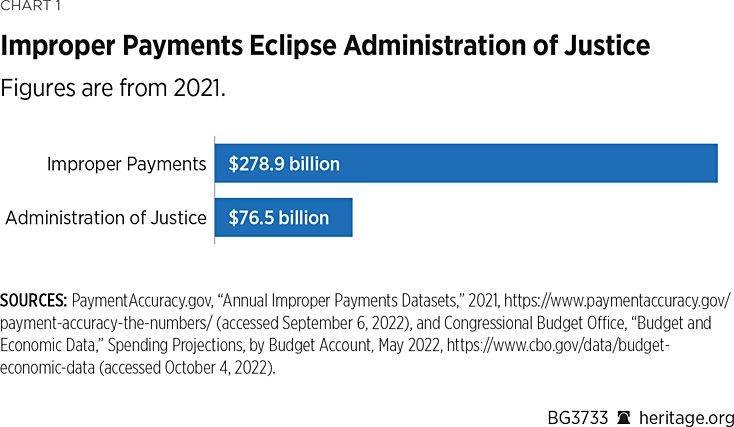
Improper Payments Likely Understated. The federal government does not track all programs’ improper payments, and those that are tracked can be difficult to pin down. Consequently, actual improper payments are likely higher than reported.
For example, Obamacare subsidies are not included in the 2021 improper payment total at all. And the pandemic unemployment insurance programs demonstrate how difficult it can be to track improper payments. According to the Department of Labor’s Office of Inspector General (OIG), the 18.71 percent improper payment rate for two of the three pandemic unemployment insurance programs is “based on the regular UI [unemployment insurance] program” and the actual improper payment rate “is likely higher than 18.71 percent.”REF Moreover, the OIG is still working on estimating improper payments in the fraudulent Pandemic Unemployment Assistance program, so that program’s improper payments are not included in the $279 billion total for 2021.REF
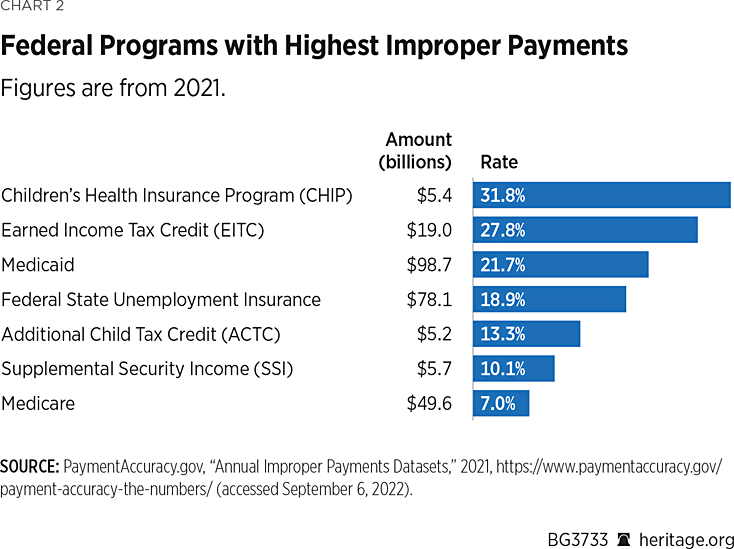
Biggest Sources of Improper Payments and Program-Specific Reforms
Among the 78 non-defense programs included in the Office of Personnel Management’s (OPM’s) 2021 improper payments report, 19 had improper payment rates in excess of 10 percent in 2021.REF Nine programs accounted for 94 percent, or $262 billion of $279 billion in total improper payments in 2021, including Medicaid, Federal–State Unemployment Insurance, Medicare (this Backgrounder combines the data from Medicare’s three programs), the Earned Income Tax Credit (EITC), Supplemental Security Income (SSI), Children’s Health Insurance Program (CHIP), and the Additional Child Tax Credit (ACTC).
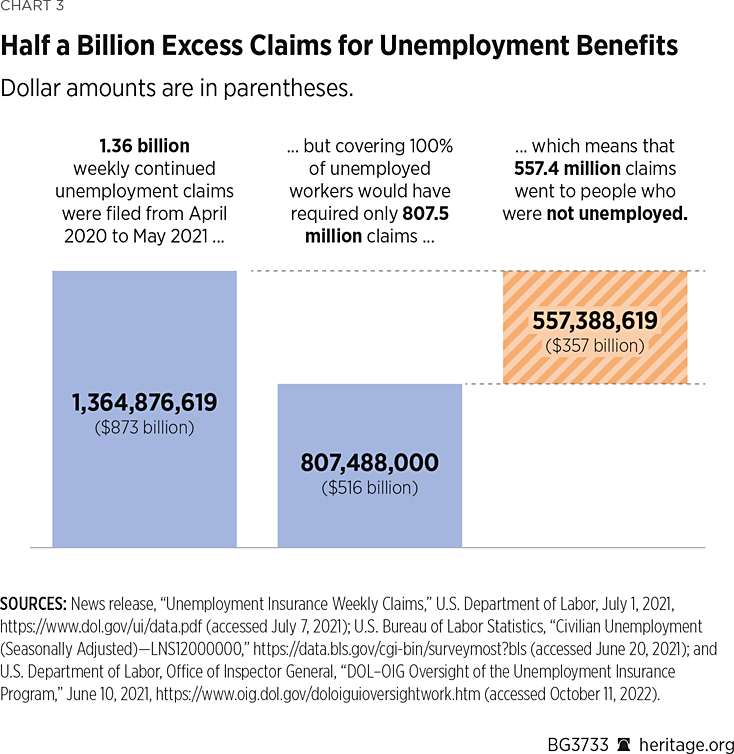
The following sections summarize the problem of improper payments in these programs and offer solutions to reduce improper payments.
Medicare. In 2021, total Medicare improper payments equaled $49.6 billion with an improper payment rate of 7.0 percent.REF Medicare fee-for-service (FFS) and Medicare Advantage account for the most. Medicare FFS has an estimated improper payment rate of 6.3 percent, representing $25.0 billion, while Medicare Advantage’s improper payment rate reached 10.3 percent, representing $23.2 billion.REF
Medicaid. Medicaid has experienced a significant jump in improper payments over the past three years. Between 2012 and 2018, Medicaid averaged $27.1 billion per year in improper payments, with a rate of 8.5 percent.REF In 2021, Medicaid’s improper payments totaled $98.7 billion, with an improper payment rate of 21.7 percent, meaning that more than one in five Medicaid dollars was an improper payment.
Children’s Health Insurance Program (CHIP). CHIP has experienced an even more significant jump in improper payments. Between 2012 and 2018, CHIP averaged $851 million per year in improper payments and a 7.7 improper payment rate.REF CHIP’s improper payment rate jumped to 15.8 percent in 2019 prior to the pandemic and was 31.8 percent in 2021. With $5.4 billion in improper payments in 2021, nearly one of every three CHIP dollars was an improper payment.
Affordable Care Act (ACA). As noted, Obamacare subsidies are not included in the official 2021 improper payment totals. However, the Health and Human Services OIG estimates that the Centers for Medicare and Medicaid Services (CMS) made $950 million in Advance Premium Tax Credit (APTC) payments that were deemed not allowable in 2018.REF Moreover, by law, the ACA limits how much the IRS can recoup from individuals who receive APTC overpayments. This is another source of improper overpayment that is unaccounted.
Ways to Reduce Improper Health Care Payments. Federal health insurance programs operate on fundamentally flawed foundations, with administrative payment systems and price controls that are divorced from the demand and supply forces of the free market. This means that most payments do not reflect the cost of delivery by the provider nor the value of the care to the patient. Yet, as measured by the government’s definition of “improper payments,” federal health insurance programs’ unnecessarily complex and confusing payment process results in significant clerical error improper payments. Unnecessary regulations, particularly related to documentation, administrative work, and non-market-based payments, also create an incentive for providers to bill improperly.
An April 2018 Health Affairs research article provides a comprehensive review of the complexity of these programs and their costs. In explaining the costly and burdensome billing and payment process, the authors note that hospitals typically have more billing specialists than hospital beds, and physician offices spend $30 billion a year on billing costs.REF
While many reforms are necessary to provide integrity and efficiency in federal health insurance programs, including shifting federal programs to a defined-contribution, consumer-driven model, there are several steps that should be taken even within the current flawed systems. Congress and the Administration should:
- Reform payment and risk adjustment in Medicare Advantage. MA payment should be delinked from the current fee-for-service benchmark and replaced with a competitive, market-based bidding process. Furthermore, the risk-adjustment mechanisms in MA should also be updated into two separate components—a prospective and a retrospective adjustment—to provide a more accurate account of payment.REF
- Hold states accountable for improper Medicaid/CHIP eligibility determinations. The Health and Human Services OIG has conducted a series of ongoing state audits and found that states have made Medicaid payments on behalf of individuals who were not even eligible for the program. Better congressional oversight of these eligibility errors is needed to hold states accountable, and Congress should direct the CMS to move more aggressively in recouping federal funds from the states for improper eligibility determinations.REF
- Remove the APTC overpayment exemption. In addition to accelerating CMS efforts to develop an improper payment program, the statute should be changed to remove the exemption for a portion of APTC overpayments to individuals. This change would remove the ability of individuals to keep any portion of erroneous advance tax credit overpayments.
Unemployment Insurance. The reported $78 billion of improper unemployment insurance payments in the OPM’s 2021 reportREF is merely an estimate based on the experience of regular unemployment insurance programs. But the Department of Labor’s OIG report notes that the true improper payment rate is likely higher than that because
[t]he unprecedented infusion of federal funds into the UI program gave individuals and organized criminal groups a high-value target to exploit. That, combined with easily attainable stolen personally identifiable information and continuing UI program weaknesses identified by the OIG over the last several years, allowed criminals to defraud the system.REF
Moreover, the reported $78 billion of improper UI payments in 2021 excludes the largest and most fraud-ridden of the three pandemic UI programs—the Pandemic Unemployment Assistance.
Taking the Labor OIG’s low-end improper payment rate and applying it across the estimated $873 billionREF in pandemic UI benefits would translate to a minimum of $163 billion in improper payments. Rachel Greszler’s own analysis compared the amount of UI payments that would have been needed to provide benefits to 100 percent of people who were unemployed (noting that, typically, only about 35 percent to 40 percent of unemployed workers receive UI benefits) to the amount of benefits that was actually paid and found that at least $357 billion in UI benefits in 2020 and 2021 went to people who were not unemployed.REF
Even with outdated systems, states failed to perform some very basic checks. Some states had weeks in which a majority of UI claims were made by people with out-of-state IDs, who presumably did not live in the state and thus should have been automatically ineligible. Arizona reported that in the summer of 2020 the number of UI claims it received was higher than its entire workforce, and that after working with a certified identity-verification company, its claims fell by 99 percent.REF
Ways to Reduce Improper Unemployment Insurance Payments. UI programs are state-run and thus policies to strengthen them should primarily be state-driven. But, considering that the massive pandemic UI fraud was borne by federal taxpayers, both federal and state lawmakers should act to reduce improper payments.
- Federal policymakers should not supersede states’ UI systems. The pandemic showed that when federal policymakers compelled expanded eligibility on states without the means to securely and effectively verify eligibility, it was nearly impossible for states to protect federal taxpayers’ money.
- Federal policymakers should condition any future federal UI funding on anti-fraud compliance. If the federal government intervenes to stipulate new rules and to pay for expanded UI benefits, states that accept federal UI assistance should be required to meet fraud-minimizing standards, such as the NIST standards.REF
- State policymakers should modernize UI programs and verify identification. At the start of the pandemic, many states were operating with unwieldy decades-old computer programs that prevented states from handling increased claims without sacrificing integrity, such as sending UI benefits to people in prison and mailing dozens of benefit checks to a single mailing address. States need to modernize their programs and include ID verification to ensure that applicants are who they claim to be before benefit checks are sent out the door.
- Federal and state policymakers should resist expansion of the UI program to non-UI participants. State unemployment insurance programs are designed for traditional employer and employee relationships, and do not work or make sense for self-employed or independent workers. It is difficult for the government and burdensome for workers to verify the employment and income of independent workers and difficult or impossible to know whether a loss in their income was by choice (not eligible for UI) or outside their control (eligible for UI). Individuals who are not employees would be better off saving on their own for unforeseen income losses, and thereby be able to access their savings without having to jump through bureaucratic hoops to receive limited benefits. Universal Savings Accounts (USAs) would serve this purpose with the advantage of increasing personal savings, especially among low-income and self-employed workers.REF
Earned Income Tax Credit (EITC). In 2021, improper payments in the EITC program totaled $19.0 billion, with a 27.8 percent improper payment rate. This is not an anomaly due to the pandemic. Over the past decade, improper payments have averaged $16.4 billion and 24.7 percent. Virtually all these improper payments have been overpayments, primarily to people who were ineligible for the credit. A 2014 IRS audit report “found that between 79% and 85% of EITC dollars claimed incorrectly were claimed by tax filers ineligible for the credit.”REF
An analysis by our Heritage Foundation colleagues Robert Rector and Jamie HallREF reported that upwards of 40 percent of all EITC filings include overpayment claims, primarily due to income misreporting and qualifying child residency errors.REF
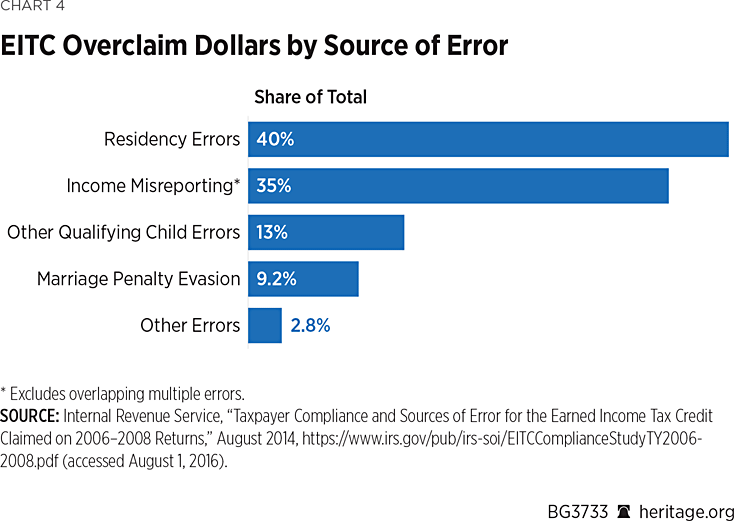
Additional Child Tax Credit (ACTC). The ACTC, which is the refundable portion of the tax credit, had a 13.3 percent improper payment rate in 2021, with $5.2 billion in improper payments. Similar to the EITC, qualifying child residency errors are major sources of improper payments. Often, absent fathers or other relatives who do not live with a child and who appear to have little or no involvement with a child will claim child tax credits on their behalf. Since verifying residency would be extremely difficult (requiring millions of manual audits), the IRS makes no serious attempt to identify and prevent these types of improper payments. Considering that certain eligibility standards are nearly impossible to verify, programmatic welfare changes are also necessary to reduce improper payments.REF
Ways to Reduce Improper Child-Related Tax Credits and Payments. Since EITC and ACTC payments are dependent on the number of children that people have and the income they earn, policymakers in charge of these programs should require that, prior to payment, administrators:
- Verify the identity of individuals who claim the EITC and ACTC.
- Confirm that the children for whom they claim these credits exist and are not claimed on more than one return.
- Verify the reported income earned before issuing EITC and ACTC payments.
- Require Social Security numbers for all EITC and ACTC payments to ensure that payments only go to individuals who have legal authority to work in the U.S.REF
- Apply minimal residency checks using secure federal databases, such as matching claimants’ addresses with children’s school addresses from school lunch program data.
- Improve tax preparer information, such as by requiring full documentation from tax preparers who prepare returns containing EITC claims or CTC claims and using this data to improve audit efficiency.REF
- Moreover, because eligibility factors, such as financial dependence and residency, are nearly impossible to verify across claimants, policymakers should:
- Reform welfare programs, including tying eligibility to individuals with legal custody of a child.REF
Key Driver of Improper Payments: Lack of Integrity and Accountability
Government programs do not have the natural integrity and accountability of private-sector businesses and programs because the people managing the programs and payments—bureaucrats and politicians—are only remotely connected to the taxpayers who have to pay for the programs. Moreover, the incentive structure for government programs—with success measured by how many people are served and how quickly benefits are delivered—leads to widespread failures in verifying people’s identities and eligibility for government programs. While these failures cost taxpayers hundreds of billions of dollars per year, they are without consequence for the agencies and programs themselves.
Weak and Underused Verification Systems. Linda Miller, the principal author of the Government Accountability Office’s (GAO’s) 2015 Framework for Managing Fraud Risks in Federal Programs, wrote that “the lack of eligibility verification is the prevailing root cause of improper payments overall.”REF Government programs often lack meaningful verification procedures, including inadequate policies, systems, and actual use. For example, the federal government has a Do Not Pay database that agencies are required to check before making payments. However, the former assistant director of Forensic Audits and Investigative Service at the GAO explained in 2022 congressional testimony that “[t]he [Do Not Pay] working system offers full access to only three of six databases required by improper payments laws and only partial or no access to the remaining three.”REF
Miller also explained that while agencies are required to use Do Not Pay prior to payment, agencies usually ping the database, send the payments, and then receive the database results after the money has gone out the door, making it unlikely that the agency will recover payments that should not have been sent.
While the federal government is attempting to increase security and reduce fraud in its programs, the government often falls behind private-sector security systems in adopting and properly applying new technologies. Login.gov, which is supposed to provide a secure sign-in service for government programs and which is one of the primary integrity and cybersecurity tools touted by the Biden Administration, is not compliant with the NIST standards. The NIST produces a set of standards and guidelines to help federal agencies meet the requirements of the Federal Information Security Management Act (FISMA). Current OMB Deputy Director for Management Jason Miller testified during a March 17, 2022, Senate hearing that Login.gov is not where it needs to be, noting that it “needs to be strengthened going forward,” including “stronger tools in place on identity verification.”REF And Login.gov is not a viable option for the IRS, in part because of its limited capacity and lack of standards. While Login.gov can provide value, its use should not be required to the exclusion of other, equally or more secure and effective private-sector systems.
Notwithstanding existing government databases and systems, many programs fail to perform even basic oversight, such as first checking whether an alleged Medicaid provider has an active medical license before sending them Medicaid payment reimbursements. In 2021, Medicaid sent out $99 billion in improper payments—with only $0.4 billion representing underpayments.REF
Near-Zero Accountability. Despite laws, such as the Improper Payments Information Act, that require agencies to identify and measure improper payments, to work with the OMB on steps to reduce improper payments, and to report to Congress on their progress, there are zero consequences even if agencies do nothing and report even higher improper payments. Without any impact on program administrators or on agencies’ budgets, and with most transfer programs structured as unlimited entitlements, it is as though federal benefit programs have no bottom line. That leads them to operate in ways that would cause any private business to fail.
Imagine if a private, long-term-care insurance provider sent only 27 percent of all its payments to the correct care providers; the company would have to charge clients two-and-a-half times the true cost of the insured care they desired, and no one would be willing to overpay that much. Moreover, any company doing that would create a tremendous financial incentive for a competitor to adopt more efficient means of reducing that gap.
But when the Veteran’s Administration uses taxpayer dollars to provide long-term services and support to veterans and has a payment accuracy rate of 27 percent (as it did in 2021), the veterans receiving the service without direct payment do not realize the true cost, nor do taxpayers who rarely hear about the government’s improper payment rates and have almost no ability to do anything about them.REF
Solution: Prioritizing Accountability and Integrity with a New Taxpayer Integrity Office. Protecting taxpayers’ money and ensuring that government resources only go toward their intended purposes and recipients requires clear rules, effective eligibility verification and information security processes, and consequences for failure to minimize improper payments. Federal agencies are all over the place in terms of their policies and procedures related to security and integrity within their payment programs. Few are doing a good job, and most of the big programs are failing miserably.
Accountability and integrity should be systemic across government. It should be easier for federal programs to protect taxpayers’ money and harder for them to waste it. And it should be easier for people to get the benefits they are qualified to receive and harder to get benefits they are not qualified to receive. These goals could be achieved—potentially with hundreds of billions of dollars in taxpayer savings annually—through a new federal Taxpayer Integrity Office within the Department of the Treasury.
A Taxpayer Integrity Office (TIO) could determine best practices related to security, eligibility verification, and information sharing and issue related recommendations and requirements covering federal agencies as well as state-administered federal programs. In addition to broad-based policies and requirements, the TIO could delegate a portion of its agents to provide tailored support and direction to individual agencies and programs. The TIO could also become a secure, central data source to prevent fraud and improve eligibility verification. Accomplishing those goals will almost certainly require Congress to amend the Privacy Act to allow limited information sharing between agencies, provided sufficient privacy and security measures are taken. An initial function of the TIO could be to identify necessary data sharing and recommend measures to protect Americans’ privacy and the security of their information.
The TIO should not require additional taxpayer resources. Initial funding could come from already appropriated resources from the Inflation Reduction Act’s $80 billion increase in the IRS budget. This would be in line with the purpose of that funding to improve accuracy in the tax system because a large portion of improper payments flow through tax filings. Within a few years, the TIO should produce multiples more in savings than it would cost—and tying the TIO’s existence to reductions in improper payments could act as an incentive to success. But without sufficient authority, the TIO could suffer a similar fate of dead-on-arrival recommendations from congressional commissions or ignored report recommendations from the GAO and Inspectors General.
The following principals and goals should guide the TIO. The new office should:
Strengthen Information Sharing Across Federal Government. Current failure to connect information across existing programs—such as the Social Security Administration’s information on individuals’ earnings and children’s Social Security numbers connected to their parents at birth—is a major source of improper payments. For example, crosschecking usage of school-meal-program benefits with where a filer’s income was earned could help to catch residency errors related to qualifying children.
The federal Do Not Pay database is a starting point, but it is inadequate. The federal government must do a better job at data sharing and the TIO could serve as a central clearinghouse to manage information sharing and eligibility verification across federal agencies and state-administered programs. In doing so, the TIO would need to establish secure sharing networks that protect personal privacy. As discussed above, this would require Congress to amend the Privacy Act. Once established, the TIO could require agencies to run eligibility checks on at least a portion of their recipients prior to issuing payments. This should include the creation of an easy-to-use, and quick turnaround, database portal that both federal and state agencies can use to verify information about a potential benefit recipient.
Improve Eligibility and ID Verification. Determining eligibility for federal programs can be difficult, especially when the eligibility criteria extend beyond easily identified metrics (age, for example, is easier to verify than a person’s living arrangements) and as one program’s eligibility criteria interacts with multiple others. (There are currently more than 80 federal welfare programs.) Policymakers should streamline benefit programs and establish bright-line eligibility criteria so that it is easier for individuals and program administrators to determine eligibility. Policymakers also need to make use of existing—and improved—government data sharing. As Linda Miller explained, “Today there are many automated, behind-the-scenes, data-driven tools that can authenticate a user and verify eligibility in near real time with little to no impact on the user.”REF The federal government needs to use proven private-sector technologies to improve government eligibility and ID verification, and to create more effective programs for intended recipients.
Maintain Competitive, Responsive, and Secure Systems. The federal government often lacks the responsiveness, innovation, and security of private-sector systems, and it lags behind in the adoption of new technology that would benefit taxpayers. The TIO’s central database should use private-sector innovation in its development and ongoing management. Privacy is a major concern in linking data between agencies, and the TIO should prioritize the protection of personal information. That includes requiring best practices within government systems and in any contracts with private-sector companies.
In addition to participating in government-wide security systems and protocols, agencies should be free to establish agency-specific or program-specific security and integrity systems, creating and maintaining them in-house or through private-sector contracts. For example, Medicaid may be required to verify a patient’s identity and enrollment in Medicaid with the TIO, but that would not weed out cases of fraud when individuals’ identities are stolen and used to obtain fraudulent payments. Thus, Medicaid could have a separate system to verify that supposed claims for Medicaid services represent claims for actual services performed by actual providers who are licensed to provide medical services.
Establish and Enforce Reasonable Standards. The 2019 OMB memorandum no. 19-17, “Enabling Mission Delivery through Improved Identity, Credential, and Access Management,” requires federal agencies to follow specific standards and actions, such as following the NIST standards and to designate an agency-wide identity, credential, and access management (ICAM) unit to effectively govern and enforce ICAM efforts, but most are not doing it.REF The TIO should be tasked with establishing clear standards and ensuring that agencies actually follow them.
Enact Meaningful Consequences for Failure. History shows that without consequences, agencies will not take sufficient action to reduce improper payments. Policymakers must provide the TIO sufficient legislative directive and authority to carry out its mission through rewards and consequences related to following the prescribed rules and meeting proper payment targets.
Imposing consequences within federal programs is not easy. For starters, financial consequences can hurt innocent program beneficiaries instead of negligent program administrators. Thus, successful stewardship of taxpayer dollars should include both consequences and rewards. That could include reductions in agencies’ discretionary budgets, demotion or dismissal of federal employees who fail to follow integrity procedures and fail to meet specified improper payment metrics, and promotions and pay increases for federal employees who achieve or exceed specified integrity metrics.
Apply TIO Rules and Procedures to State Agencies that Administer Federal Programs. States that administer federal payment programs like Medicaid and food stamps could benefit from access to federal data to help determine eligibility. The TIO should require states to follow the same data-verification procedures as federal program administrators, and states should be required to provide data to the federal government to track who is receiving state-administered federal benefits. States should also have to follow the same standards of accountability and integrity as the federal government in administering federal payment programs, and should be subject to consequences, such as reduced federal payment shares, for failure to meet required data sharing and integrity and accountability standards.
Growth in Government Comes with Exponential Growth in Improper Payments
Some level of improper payments is inevitable within the federal government, but the recent exponential rise is indefensible. Between 2005 and 2021, GDP increased by 79 percent, government program payments rose by 228 percent, and improper payments skyrocketed by 522 percent.REF In other words, improper payments grew at nearly seven times the rate of GDP.
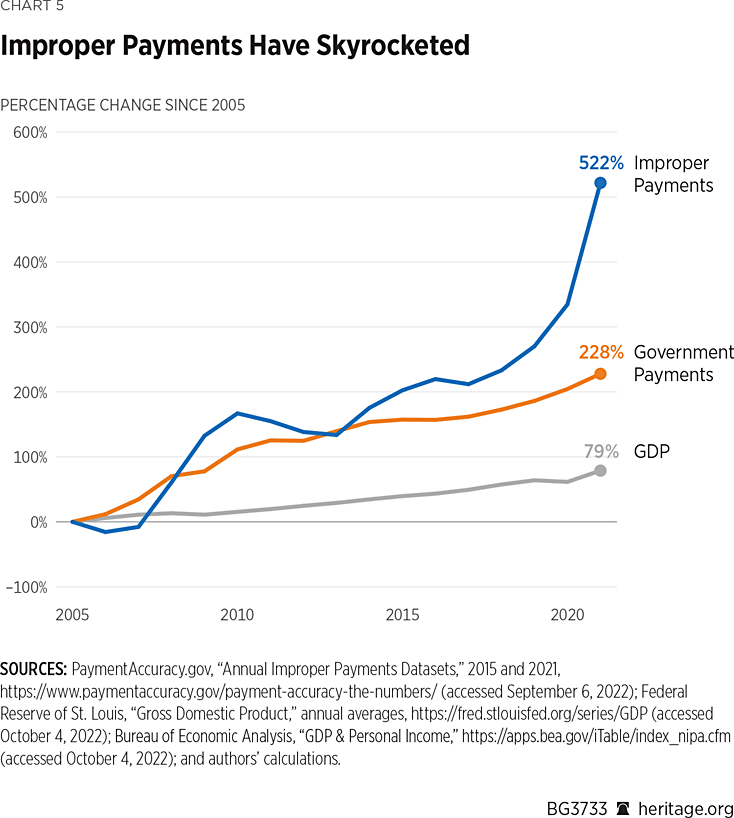
Exponential growth in the size of improper payments owes to two things. First, no one ever spends other people’s money more carefully than they spend their own and the same is true of the federal bureaucracy spending taxpayers’ money. And, second, the federal government has expanded so far beyond its original purpose of providing a common defense and system of justice that efficiency and accountability have gone by the wayside. Virtually all the $3.3 trillion in federal payments sent out in 2021 were payments for things outside the traditional functions of the federal government.REF
In 2021, four of every five tax dollars the federal government collected, and one of every two dollars it spent, went to transfer payments.REF The federal government currently spends four times as much transferring money from some people to others as it does on national defense and the justice system combined. Even as the expansion of government transfer programs may appear to be providing people with benefits, it is not making them better off. Taking more of everyone’s earnings, establishing hundreds of eligibility-based programs, and requiring people to follow bureaucratic and often-complicated processes to receive program benefits is inefficient and generally leaves people with lower incomes and less control over their lives. The creation of government programs that attempt to solve social ills has also crowded out the benefits of family and of civil society.
Payments from federal programs typically require a bureaucratic application and receipt process and they come with conditions that alter the ways that Americans live their lives and run their businesses. For example, some lawmakers want to expand the UI system to include individuals who are self-employed or independent workers, but the pandemic unemployment assistance program that did just that suffered enormous fraud and improper payments because it is extremely difficult to verify eligibility among the self-employed as most of the data is self-reported. Moreover, all self-employed individuals would be forced to pay part of their earnings into a UI system that would subject them to a bureaucratic process when they would be far better off saving for their own in a USA that they could access without jumping through government hoops.REF
Another example of a proposal that would replace something families currently do on their own with a government program is a new federal childcare entitlement.REF But in addition to putting the government instead of parents in control of childcare, driving up childcare costs, crowding out smaller providers, and excluding faith-based childcares,REF a new childcare entitlement would suffer from high rates of improper payments. The proposed childcare entitlement would run through the states—further disincentivizing accountability—and it would function similarly to Obamacare subsidies that had improper payment rates of between 12 percent and 27 percent.REF
Ways to Increase Government Efficiency, Expand Self-sufficiency and Opportunity. To simultaneously create a more efficient government, give individuals more autonomy and income, and reduce improper payments, policymakers should:
- Reduce or eliminate tax credits and substitute them with lower tax rates. Fewer tax credits would directly reduce improper payments associated with refundable tax credits. Fewer tax credits would allow lower overall tax rates. When people pay less in taxes, they have more money to spend and save on their own, which means that they have less need for government programs. Whereas tax credits can be complicated, and they require eligibility checks, eligibility for lower overall tax rates would be universal and based exclusively on income earned that is already reported in taxes. The $171 billion that the federal government issued in tax credits in 2021 could have instead been used to reduce individual and personal income taxes by 7 percent across the board, benefitting all taxpayers.REF
- Reject new and expanded entitlement programs and empower average Americans instead of politicians and bureaucrats. Most major entitlement programs tax people and then give them a proscribed benefit. While some people end up with more than they paid and others get back far less or nothing at all, the tax-and-transfer structure limits personal control. A new childcare or paid family leave entitlement, such as that included in the proposed Family And Medical Insurance Leave (FAMILY) Act,REF would disproportionately benefit higher-income families—providing no benefit at all to many workers who would be required to fund them.REF Moreover, instead of expanding access, government programs would restrict the type of childcare parents could choose and limit workers’ use of paid family leave.REF There are other ways policymakers can help workers and families to achieve their personal goals without expensive new entitlement programs. The Working Families Flexibility Act would expand workers’ access to paid family leave without government intervention, while allowing low-income families to use Head Start funds at a childcare provider of their choice would increase childcare access and affordability.
- Reform existing entitlement programs to build independence, ownership, and autonomy. History shows that entitlement programs continually grow in size and scope over time, passing the buck of excessive spending to future generations. Social Security started out as a 2 percent tax and promised to never take more than 6 percent of workers’ earnings—now it takes 12.4 percent and keeping the program solvent would require a 15.6 percent tax.REF These high taxes make it harder for workers—especially lower-income ones—to save money and to afford what they need for their families. Policymakers should make Social Security solvent through commonsense reforms that tailor it to those in need while also providing an option for individuals to build wealth that they own and can pass on to their heirs.
- Enact Universal Savings Accounts (USAs) so that more Americans can save in a single, simple, tax-free account for whatever needs arise. When taxed less, Americans can save more, and when people have more savings, they do not have to navigate as many eligibility-based social programs. Evidence shows that low-income people are the most likely to increase their savings when restrictions on their access to those savings are removed.REF
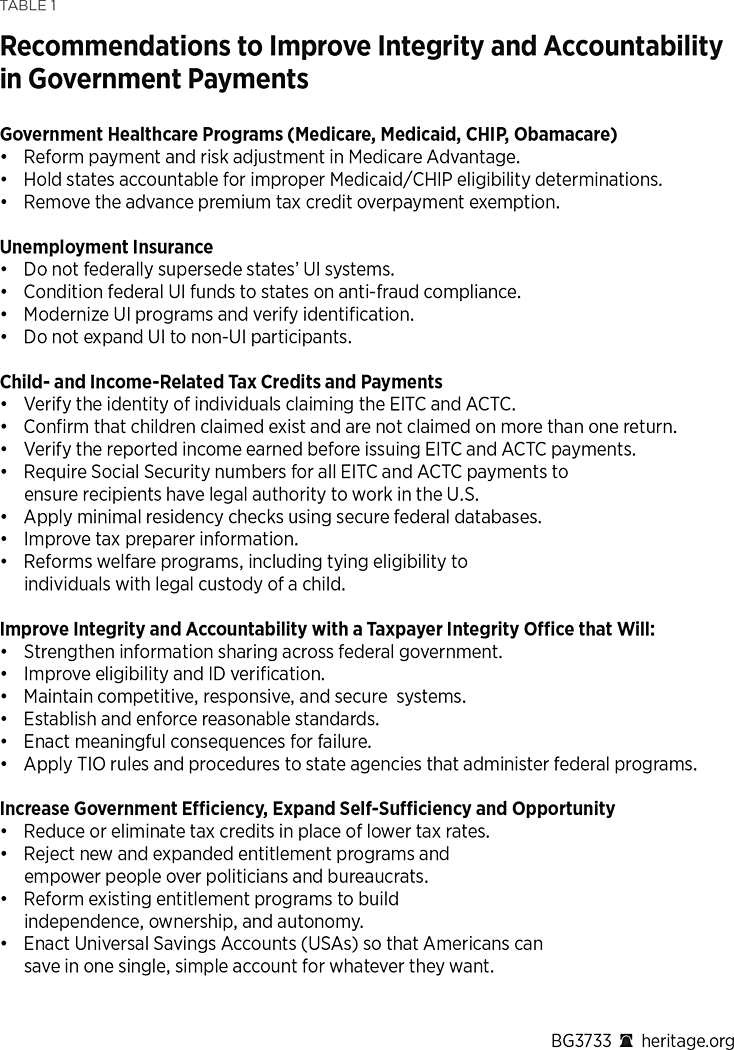
Conclusion
Improper government payments are at unacceptably high levels, exceeding $279 billion in 2021 (even excluding many programs, such as Obamacare subsidies and the Pandemic Unemployment Assistance program), with some programs paying out more than one of every four dollars improperly. Preventing improper payments requires four key components:
- Determining whether individuals filing for benefits are who they claim to be,
- Verifying that they are eligible for the benefits they claim,
- Imposing accountability on program administrators who fail to follow required system checks and who exceed improper payment limitations, and
- Limiting the number of government programs Americans need to interact with in their everyday lives.
The disastrous pandemic UI programs demonstrate the massive consequences of failure on all four of these components. As cybersecurity threats will only continue to grow and improper payments have been expanding at an exponential rate, it is imperative that policymakers learn from these failures and act now to protect Americans’ hard-earned tax dollars and personal identities.
While standards exist to significantly improve identity verification, as do program-specific policy reforms that would enhance eligibility verification, many government agencies are not applying these standards or implementing the necessary policy changes. This includes the failures of agencies to take actions of which they are already capable or are supposed to be doing on their own, and policy changes that require administrative or legislative action. Improved accountability could make it easier for those who are supposed to receive benefits to get them and less likely for those who are not to receive payments improperly.
In addition to taking needed measures to protect the integrity of existing government programs, policymakers should also seek to limit the number of government programs with which Americans need to interact. Not only are government programs a source of improper payments and a potential for identity theft, but they replace personal autonomy and opportunity with bureaucratic control and smaller disposable incomes, ultimately leaving many people worse off. Policymakers could better protect taxpayers’ dollars by taking less in taxes and redistributing less in payments so that Americans can decide—without bureaucratic approval—what they want to spend their money on and when they want to spend it.
Rachel Greszler is Senior Research Fellow for Budget and Entitlements in the Grover M. Hermann Center for the Federal Budget at The Heritage Foundation. Nina Owcharenko Schaefer is Director of the Center for Health and Welfare Policy at The Heritage Foundation.




